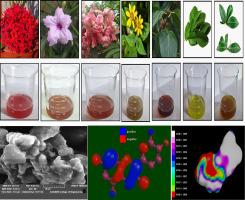从植物生物废弃物到绿色可持续的酸碱指标:提取、植物化学筛选和量子模拟
Q1 Environmental Science
引用次数: 0
摘要
天然植物提取物因其多样的化学成分及其在科学领域的广泛应用,近年来引起了人们的广泛关注。为了提供一种环境友好的合成指示剂替代品,本研究研究了利用植物废弃物(包括黑木条、无花果、石榴、柠檬的叶提取物,以及Ixora coccinea、Mussaenda philippica和Ruellia tuberosa的花提取物)作为酸碱指示剂。利用UV-Vis、FT-IR、FESEM、物理特性(密度、粘度、表面张力和折射率)和定性植物化学筛选对植物提取物进行了表征和分类。紫外可见光谱在245 ~ 247nm范围内存在一个吸收带,对应于n→π*跃迁。在水环境中,提取物中的发色团可以改变电子跃迁(n -π *)并根据pH值重新排列。FT-IR光谱清楚地显示了提取物中羟基和羰基基团,它们在碱性和酸性环境中改变了它们的结构并影响了提取物的颜色。扫描电镜结果表明,不同组分在其片段中的存在是造成植物提取物形态差异的原因。对植物生物废弃物提取物的植物化学参数进行了筛选、分类和制表,提供了一个在广泛的酸碱区间内测试实际可行性的短库。在密度泛函理论(DFT)的研究中,低能隙(HOMO-LUMO隙)表明分子可以通过吸收光的光子而更容易被激活。滴定分析表明,合成指示剂(酚酞)得到的终点与萃取物的终点一致,误差%(1.58 ~ 4.54)较小,这意味着植物萃取物有希望作为替代酸碱滴定的生物质。所使用的特定植物叶和花价格合理,易于获得,制备简单,实用,环保,酸碱滴定准确。本文章由计算机程序翻译,如有差异,请以英文原文为准。

From plant biowaste to green and sustainable acid-base indicators: Extraction, phytochemical screening, and quantum simulation
Natural plant extracts have attracted a lot of interest lately because of their varied chemical composition and their uses in a range of scientific domains. In order to provide an environmentally benign substitute for synthetic indicators, this study investigates the use of plant wastes (including leaf extracts from Aspilia, fig, pomegranate, lemon, and flower extracts from Ixora coccinea, Mussaenda philippica, and Ruellia tuberosa) as acid-base indicators. The plant extracts were characterized and classified using UV–Vis, FT-IR, FESEM, physical characteristics (density, viscosity, surface tension and refractive index), and qualitative phytochemical screening. The presence of an absorption band in the range of 245 to 247 nm in the UV–Vis spectra corresponds to n → π* transitions. The chromophore groups in the extracts can change electron transitions (n–π*) and rearrange based on pH in the aqueous environment. FT-IR spectra clearly show the hydroxyl and carbonyl groups in the extract moieties, which vary their structure in basic and acidic environments and affect the extract colour. SEM results shows that, the presence of various components in their moiety is the cause of the variance in the morphology of plant extracts. Phytochemical parameters of plant biowaste extracts were screened, classified, and tabulated providing a short library of practical feasibilities tested over a wide acidic-basic interval. In Density Functional Theory (DFT) research, a low energy gap (HOMO-LUMO gap) shows that a molecule can be activated more readily by absorbing a photon of light. The titrimetric analysis shows that the endpoint obtained from the synthetic indicator (phenolphthalein) coincides with the endpoint of extracts with less error % values (1.58–4.54), means that plant extracts were promising as a substitute biomass for acid-base titrations. The particular plant leaves and flowers used are affordable, readily available, simple to prepare, practical, environmentally friendly, and accurate for acid-base titrations.
求助全文
通过发布文献求助,成功后即可免费获取论文全文。
去求助
来源期刊

Bioresource Technology Reports
Environmental Science-Environmental Engineering
CiteScore
7.20
自引率
0.00%
发文量
390
审稿时长
28 days
 求助内容:
求助内容: 应助结果提醒方式:
应助结果提醒方式:


